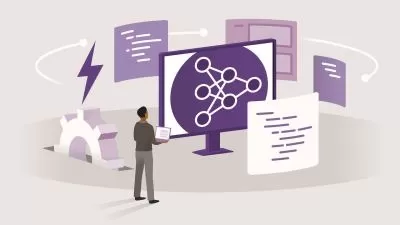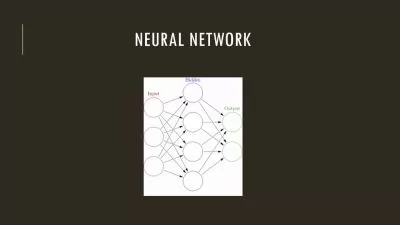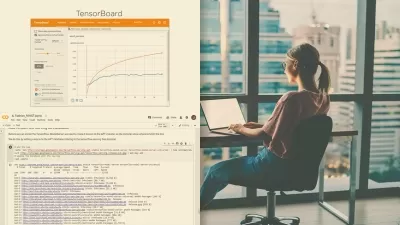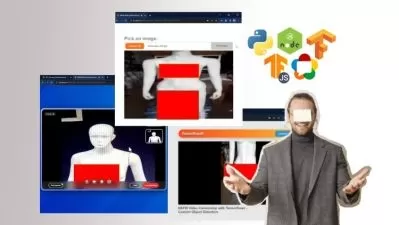Deep Learning : Image Classification with Tensorflow in 2023
Neuralearn Dot AI
32:28:03
Description
Master and Deploy Image Classification solutions with Tensorflow using models like Convnets and Vision Transformers
What You'll Learn?
- The Basics of Tensors and Variables with Tensorflow
- Linear Regression, Logistic Regression and Neural Networks built from scratch.
- Basics of Tensorflow and training neural networks with TensorFlow 2.
- Convolutional Neural Networks applied to Malaria Detection
- Building more advanced Tensorflow models with Functional API, Model Subclassing and Custom Layers
- Evaluating Classification Models using different metrics like: Precision,Recall,Accuracy and F1-score
- Classification Model Evaluation with Confusion Matrix and ROC Curve
- Tensorflow Callbacks, Learning Rate Scheduling and Model Check-pointing
- Mitigating Overfitting and Underfitting with Dropout, Regularization, Data augmentation
- Data augmentation with TensorFlow using TensorFlow image and Keras Layers
- Advanced augmentation strategies like Cutmix and Mixup
- Data augmentation with Albumentations with TensorFlow 2 and PyTorch
- Custom Loss and Metrics in TensorFlow 2
- Eager and Graph Modes in TensorFlow 2
- Custom Training Loops in TensorFlow 2
- Integrating Tensorboard with TensorFlow 2 for data logging, viewing model graphs, hyperparameter tuning and profiling
- Machine Learning Operations (MLOps) with Weights and Biases
- Experiment tracking with Wandb
- Hyperparameter tuning with Wandb
- Dataset versioning with Wandb
- Model versioning with Wandb
- Human emotions detection
- Modern convolutional neural networks(Alexnet, Vggnet, Resnet, Mobilenet, EfficientNet)
- Transfer learning
- Visualizing convnet intermediate layers
- Grad-cam method
- Model ensembling and class imbalance
- Transformers in Vision
- Huggingface Transformers
- Vision Transformers
- Model deployment
- Conversion from tensorflow to Onnx Model
- Quantization Aware training
- Building API with Fastapi
- Deploying API to the Cloud
Who is this for?
More details
DescriptionImage classification models find themselves in different places today, like farms, hospitals, industries, schools, and highways,...
With the creation of much more efficient deep learning models from the early 2010s, we have seen a great improvement in the state of the art in the domain of image classification.
In this course, we shall take you on an amazing journey in which you'll master different concepts with a step-by-step approach. We shall start by understanding how image classification algorithms work, and deploying them to the cloud while observing best practices. We are going to be using Tensorflow 2 (the world's most popular library for deep learning, built by Google) and Huggingface
You will learn:
The Basics of Tensorflow (Tensors, Model building, training, and evaluation)
Deep Learning algorithms like Convolutional neural networks and Vision Transformers
Evaluation of Classification Models (Precision, Recall, Accuracy, F1-score, Confusion Matrix, ROC Curve)
Mitigating overfitting with Data augmentation
Advanced Tensorflow concepts like Custom Losses and Metrics, Eager and Graph Modes and Custom Training Loops, Tensorboard
Machine Learning Operations (MLOps) with Weights and Biases (Experiment Tracking, Hyperparameter Tuning, Dataset Versioning, Model Versioning)
Binary Classification with Malaria detection
Multi-class Classification with Human Emotions Detection
Transfer learning with modern Convnets (Vggnet, Resnet, Mobilenet, Efficientnet)
Model Deployment (Onnx format, Quantization, Fastapi, Heroku Cloud)
If you are willing to move a step further in your career, this course is destined for you and we are super excited to help achieve your goals!
This course is offered to you by Neuralearn. And just like every other course by Neuralearn, we lay much emphasis on feedback. Your reviews and questions in the forum will help us better this course. Feel free to ask as many questions as possible on the forum. We do our very best to reply in the shortest possible time.
Enjoy!!!
Who this course is for:
- Beginner Python Developers curious about Applying Deep Learning for Computer vision
- Deep Learning for Computer vision Practitioners who want gain a mastery of how things work under the hood
- Anyone who wants to master deep learning fundamentals and also practice deep learning for image classification using best practices in TensorFlow.
- Computer Vision practitioners who want to learn how state of art image classification models are built and trained using deep learning.
- Anyone wanting to deploy image classification Models
- Learners who want a practical approach to Deep learning for image classification
Image classification models find themselves in different places today, like farms, hospitals, industries, schools, and highways,...
With the creation of much more efficient deep learning models from the early 2010s, we have seen a great improvement in the state of the art in the domain of image classification.
In this course, we shall take you on an amazing journey in which you'll master different concepts with a step-by-step approach. We shall start by understanding how image classification algorithms work, and deploying them to the cloud while observing best practices. We are going to be using Tensorflow 2 (the world's most popular library for deep learning, built by Google) and Huggingface
You will learn:
The Basics of Tensorflow (Tensors, Model building, training, and evaluation)
Deep Learning algorithms like Convolutional neural networks and Vision Transformers
Evaluation of Classification Models (Precision, Recall, Accuracy, F1-score, Confusion Matrix, ROC Curve)
Mitigating overfitting with Data augmentation
Advanced Tensorflow concepts like Custom Losses and Metrics, Eager and Graph Modes and Custom Training Loops, Tensorboard
Machine Learning Operations (MLOps) with Weights and Biases (Experiment Tracking, Hyperparameter Tuning, Dataset Versioning, Model Versioning)
Binary Classification with Malaria detection
Multi-class Classification with Human Emotions Detection
Transfer learning with modern Convnets (Vggnet, Resnet, Mobilenet, Efficientnet)
Model Deployment (Onnx format, Quantization, Fastapi, Heroku Cloud)
If you are willing to move a step further in your career, this course is destined for you and we are super excited to help achieve your goals!
This course is offered to you by Neuralearn. And just like every other course by Neuralearn, we lay much emphasis on feedback. Your reviews and questions in the forum will help us better this course. Feel free to ask as many questions as possible on the forum. We do our very best to reply in the shortest possible time.
Enjoy!!!
Who this course is for:
- Beginner Python Developers curious about Applying Deep Learning for Computer vision
- Deep Learning for Computer vision Practitioners who want gain a mastery of how things work under the hood
- Anyone who wants to master deep learning fundamentals and also practice deep learning for image classification using best practices in TensorFlow.
- Computer Vision practitioners who want to learn how state of art image classification models are built and trained using deep learning.
- Anyone wanting to deploy image classification Models
- Learners who want a practical approach to Deep learning for image classification
User Reviews
Rating
Neuralearn Dot AI
Instructor's Courses
Udemy
View courses Udemy- language english
- Training sessions 86
- duration 32:28:03
- Release Date 2023/03/29






















